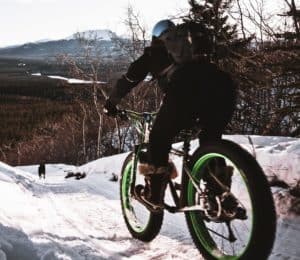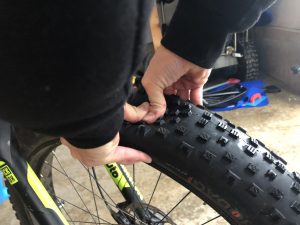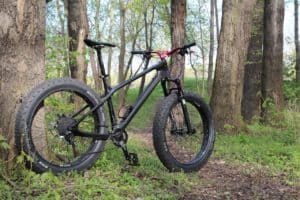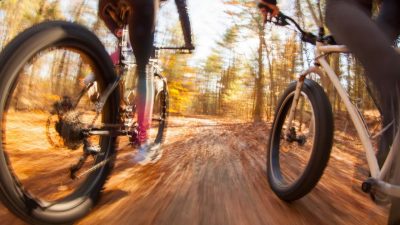With Summer in full bloom, you may be dusting off your old bike and inflating those rubbery tires. Well sure, you could do that, or you could make this season of riding memorable with a fat bike (aka fatbike).
What is a fat bike? A fat bike is a type of bicycle designed for snow and sand riding. It earns its name because the larger 3-5″ tires. Having the tire pressure between 2-5 psi, it makes it possible to ride on sand and especially snow with relative ease.
If you’re thinking of upgrading your tired old mountain bike to something a little more exciting, we implore you to read on. In this article, we’ll delve into all things fat bike: they’re history, they’re design, and most importantly, the pros and cons of fat bikes.
What Is a Fat bike?

As we touched on in the intro, a fat bike gets its name from its tire size. These are bigger and thus fatter than the tires of an average bicycle.
Most fat bike tires are between 3.8 inches and 5 inches. This is one part of a fat bike’s design that lends these bicycles the ability to traverse a variety of terrain.
Another great design element for offroading in the size of the fatbike’s rims. These are wider to decrease ground pressure as low as possible.
Most fat bike rims are a little more than two inches or 55 millimeters. Due to the wider rims of fat bikes, they need to have stays and forks that are just as wide.
Since ground pressure is how much pressure the bike tires put on softer terrain, lower ground pressure is ideal. This lets your fat bike traverse soft terrain that’s not necessarily super stable, including mud, bogs, sand, and snow.
When filling the tires of your fat bike, it’s better to keep the pressure far lower than what you’re used to. Don’t exceed much past 10 pounds per square inch or PSI.
In fact, some riders have found that a tire pressure of 5 PSI is suitable for specific conditions. Fatbikes can also handle tougher terrain like mountain biking trails and pavement.
The History of the Fat bike?

Where exactly did fat bikes come from? They are a newer creation that has been around since the 1980s. That said, the groundwork for creating the fat bikes we know and love today may have existed for some time at the start of the 1900s.
Jean Naud of France designed a longtail bike in 1980 that had strikingly large tires. The idea caught on to the point that tire brand Michelin made their own fat bike tires for Naud to use as he rode his bike long distances.
While Naud may have technically had one of the first fat bikes, they weren’t available to the public yet. That would come later.
Two places in the United States progressed the progress of these bikes: New Mexico and Alaska.
In New Mexico, a man named Roy Molina created his own version of a fat bike, which had tires that were 3.5 inches and rims that were a little more than three inches.
Over in Alaska, Icycle Bicycles’ Steve Baker made another version of a fat bike by welding it. These bikes were lent to cyclists, who rode them to such places as the Iditarod Trail.
By the 1990s, John Evingson and Mark Gronewald, both of Alaska, made their first fat bike together. It had the same tires and rims that Alaska’s Roy Molina had designed.
Gronewald was actually the one who came up with the “fat bike” term way back in 2001. These bikes began selling, and fat bikes took off from there.
What Are the Benefits of This Type of Bike?
Are you thinking of getting into fat biking yourself? It turns out there are many benefits to doing so. Here’s an overview of the perks of the lifestyle.
Explore That New Trail
Have you ridden all the bike trails in your city or town…several times over? If so, then by this point, hitting one of these trails is so ingrained in you that you can almost ride it with your eyes closed (although we don’t recommend doing this, obviously!). You can’t help but be a little bored.
With fat biking, you don’t have to ride that same boring path for the twentieth or even hundredth time. You can explore something new by taking that rock or dirt trail you’ve always seen but could never ride before.
Why not forge your own path while you’re at it? Take this trail as far as it goes and see where you are when you get there. Just be careful not to get too lost on your adventures. (Source)
See Nature in a New Way

There’s something about riding off-road that really gives you a fresh appreciation for Mother Nature and all her bountiful gifts.
For instance, have you ever ridden your bike in the snow before? Probably not, right? After all, why would you? Traditional bikes aren’t meant for handling such slick conditions, but a fat bike can.
There’s something so mystifying and magical about cutting through a thick blanket of fluffy snow that was previously untouched. The crispness of the winter scene, the snow lingering beautifully in the tree branches, and the stillness of the world around you is something that has to be seen and experienced to really believe.
Get Some Great Exercise
Whether you want to lose some weight or find an alternative to the gym, a fat bike is a great option either way. According to Bicycling.com, if you ride for an hour, you can torch 1,500 calories.
Not only that but if you wanted to do the same thing tomorrow, you theoretically could. That’s because Bicycling.com adds, your body enters recovery mode right away after a fat biking session. You’ll be ready to go after 60 minutes of fat biking sooner than you would if you spent that same amount of time running.
This is all due to how your body bears weight when you do certain activities. Fatbiking is not a weight-bearing activity, even though you must be strong and have great balance when riding. Running is, which is why recovery takes longer. (Source)
Meet a Welcoming Community
The fat bike community is full of passionate riders like you. You don’t have to live in Alaska to find someone who likes this hobby as much as you do, either. If you hang around specialty bike shops, you’re sure to bump into another fat bike enthusiast.
You can always use social media to connect with other fat biking fans as well. There you can meet up and ride together! Your new friends could introduce you to trails you’ve never even heard of.
Take Your Tires Further

The average tire pressure for a traditional mountain or city bicycle is between 30 PSI to 130 PSI. For fat bikes, it’s as low as 2 PSI and as high as 10+ PSI. That’s it. With such low tire pressure, you don’t need to worry about refilling nearly as often as traditional bike riders do.
Sometimes you will exceed 10 PSI, but it depends on the conditions. If you’re riding rocky terrain, for example, you could increase the tire pressure to 14 PSI with no ill effects.
Just don’t go too high or else you’ll bounce as you ride. This can be dangerous, depending on the terrain. A PSI that’s too low can also bounce, so test and experiment until you find a comfortable tire pressure that doesn’t cause you to bounce.
I’ve gathered the 10 advantages that I could think of plus asked a few of my fellow bat bikers about what they like most when it comes to riding their fat bikes!
9 Fat Bike Pros
Fat biking is not an easy sport, that’s why riding one sometimes feel so much more rewarding than riding a traditional mountain bike. Here are 9 fat bike pros to make you a believer!
1. Punctures Are a Thing Of The Past

Well, not entirely, but at least they are not as prone to punctures as other normal mountain bikes are. This excellent immunity to pinch flats stems from the use of low-pressure tires which exert little force on the ground for pointy things to pierce through.
Besides that, it would also take a tremendous amount of effort to get through a 3.5-pound tire held in place by a 3-inch rim.
That’s not to say that fat bikes can never get flats because as long as thorns continue to exist that will always be an ever-present risk. However, they are desirable because they can be seamlessly made tubeless, thereby getting around that problem altogether.
Therefore, staring down at a flat while you’re a long way from home in the backdrop of an impending storm is something you’ll only hear about from other people because you’ll most likely never experience it yourself.
2. Where Can’t It Go?
For an ordinary mountain, the answer to that is a lot of places. For a fat bike, well, it seems the sky is the limit. If you like to venture across terrains where only mountain goats can hack it, these kinds of bikes are your safest bet.
The immense traction and vast grip offered by huge tires ensure they make light work of the most grueling of surfaces. Be it muddy paths, wet stone, or snowy hills, nowhere is out of bounds.
This excellent cycling power is all down to simple physics. The increased contact surface area reduces the sum total of pressure acting on the ground hence why the bike won’t slip on snow or even the mellowest sandy beaches. Something that cannot be said of a regular MTB.
3. Unrivalled Ride Comfort

The low tire pressure affords high levels of comfort hence why they need not be inflated too much. Between 4 and 8 psi proves the ideal range with it able to handle even lower pressure than that without significantly increasing the peddling task on the rider. (Source)
Of course, the amount of air in your tires will strongly coincide with the type of terrain you’ll be traversing. Be it sand, snow, pavement, and of course, your typical mountain bike trail.
Moreover, while technically fat bikes don’t have any suspension system in place as they instead have a rigid and compact frame, the fat tires double up as all the suspension you’ll ever need while on snow, sand, and pavement.
They tend to become squishier as a result of increased rubber elasticity at low pressure, and this soaks up bumps and shocks during cycling. My fatty has a front suspension because I ride my fat bike on a lot of MTB trails and the added suspension is a great feature to have.
4. Little Maintenance Work
A scan of the body of the fat tire bike and instantly becomes clear that simple is the prevailing theme as far as the bike frame is concerned.
Very little work is put into it, but that is, in fact, a good thing. The robust build alleviates the use of moving or delicate parts, thereby circumventing damage and the need for replacement.
Sure you’ll pay through the nose for a fat bike at first, but the return on investment makes it a worthwhile purchase in the long run.
A seemingly exorbitant price tag is well leveled off by an almost non-existent maintenance expenditure, Mostly because crashing on snow and sand is much less destructive on your bike than an MTB trail!

5. A Real Challenge
As mentioned before, fat bikes are great on soft surfaces and snow. No doubt about that. But that’s not to say that riding one is as easy as taking a walk in the park because it isn’t. And fat bike enthusiasts wouldn’t have it any other way.
The one sped capability ensures you’re in for some huffing and puffing. But it is desirably welcomed that that is the case because it affords high-impact exercises to work the muscles thoroughly.
If finding some time for the gym has proven as elusive as a midday sun in Antarctica, incorporating this bike into your routine is sure to help you stay fit. (Source)
6. Great For Newbies
Long ago, learning to ride a bike involved a whole lot of falling than riding. Hence why certain difficulties in life are faced with the encouragement of getting back on the saddle and trying again.
Now though, the fat tire bike ensures you’ll not fall as often courtesy of the huge tires that offer better balance.
Even someone who’s never touched a bike in his/her life takes to the fat tire bike like a duck to water. It’s that easy. Plus, the limited speed imposed by the bulky nature of the bike sees to it that injuries are of a lesser severity compared to when honing your skills with a standard mountain bike. (Source)
7. A Whole Lot Of Fun
Who says fat bikes aren’t fun because they provide that in spades. They offer a different perspective to cycling and the distinct features and look make riding all the more enjoyable.
In fact, experienced riders have said that the fat bike feels kind of like riding a horse and a bike at the same time. It might not have the blistering pace of the animal, but that’s not the point of a fat bike. The point is taking in the outdoors whilst keeping at a soothingly slow pace.
Fun also comes in the ability to get to those hard-to-reach areas where a normal bike can’t dare to venture. What’s more, it also offers a nice excuse to socialize. Its unique characteristics are sure to earn you a couple of stares- and a few words as well- from curious passersby.
8. Access To Unique Competitions

If you ever wanted to feel part of a secret club or something of the sort, a fatbike offers that exclusivity you so desire. Their slower pace means they can’t take part in ordinary MTBs races, thereby necessitating the need for events explicitly targeting this group of riders.
You’ll get the opportunity to meet other fat bike lovers- maybe learn one or two pointers along the way- while pitting your skills against worthy opponents.
Such events are also an excellent place to witness enthralling fat bike variations. Kind of like a car show which brings together all manner of eccentric mods and reimagination.
9. Staying In Shape All Year!
The one thing that I love the most about my fat bike is the fun I can have with a bike all year round! I ride my MTB in the summer and fall months and my fat bike mostly in the winter months.
I, of course, like riding my fatty in the summer. It’s fun to switch it up and flip your regular routine on its head!
The best thing about being able to ride your bicycle during all four seasons is that you won’t need a stationary bike to stay in shape. When the snow melts, you’ll be ready to hit the trails on your MTB!
Are you on the fence regarding the fat tire bike? Well, as you can see, it’s not a bad option for experienced or inexperienced rider alike. It’s versatile; it’s fun, requires little maintenance, and offers excellent durability.
Fat bikes or Fatties’ are they so commonly go by have been around for quite some time now. Although they have only gained popularity within the mainstream cycling industry’s attention in the last few years, and it is for a good reason.
Even with their somewhat unusual appearance, it seems that these bikes are here to stay. Not only are they versatile, but they are also a delight, especially in extreme adventure conditions and races.
What’s more, their soft ride and versatility render them the ideal all-round specialty cycle or bike. However, despite their reputation as a uniquely adaptable ride, fat bikes are unfortunately not all butter and gold’…they too have their own set of limitations and downsides.
9 Fat Bike Cons
With all the advantages of fat bikes, there are also some disadvantages. Here is a list of the most common disadvantages of fat bikes.
1. Fat Bikes Are Expensive
As a first, most, if not all, fat bikes, including the base models, are relatively more costly compared to a basic hybrid or road bike. This is primarily due to the various specialty components such as rims, tubes, as well as large tires, among other components.
In fact, a standard quality fat bike goes for an average of $1,500. Owning a fat bike is a massive initial investment. A factor that can significantly limit any adventurous individual who is merely looking to test a new way to cycle.
In areas where fat bikes are common, you can quickly locate bike outlets that rent out fat bikes for an agreed time frame. This is a great approach to preview a fat bike without entirely investing in one.
Click this link for my full review of a “good” budget fat bike from Costco!
2. They Are Heavy
Another downside to fat bikes is, of course, their weight. As earlier mentioned, the presence of specialty components such as rims, large tires, and tubes tend to make fat bikes relatively more cumbersome compared to standard touring or mountain bikes.
Typically, base models can weigh an average of between 33 and 36 pounds, whereas premium models weigh at just below 30 pounds. With the complete custom fat bikes are usually structurally scaled down to around 22 pounds.
Although some fat bike manufacturers are currently selling fat bike frames in somewhat lighter material such as carbon fiber, they are however too expensive unless you can afford it.
Nonetheless, less costly or most beginner models tend to be heavy.
3. Quite a Bit Slower
The unique combination of the relatively heavier frames and decreased tire pressure subsequently means that Fatties are normally much slower compared to other models.
What’s more, when it comes to regular trails, the rolling resistance, and increased weight will eventually mean that not only will you be annoyingly slow; you also won’t enjoy any precision at all!
As such, for anyone looking for a bike to get you around the neighborhood quickly, fatties are probably not the best option.
4. Less Grip on Typical Grounds
What’s more, while fat bikes are all famous for their ability to comfortably cruise somewhat tricky terrains such as deep mud areas or snow.
When you are not looking to tackle deep muddy sections, simply floating atop mud under normal circumstances will mean less grip and less bite.
Similarly, fat bike tires are quite unsafe particularly on gravel, since the bike’s large surface area will get to the gravel as if the bike is on ball bearings! This, of course, all depends on the type of tires you’re riding on. Better tires will mean better traction.
Keep in mind that I’m talking about cheap fat bike tires when I talk about the fact that they have less traction.

5. Harder to Pedal
Anyone who has heard of fat bikes will probably tell you that they are popular for their ability to float over problematic surfaces. However, whether or not this is true, their relatively heavy characteristic is also a significant detriment.
This increased weight renders fatties fairly more challenging to pedal on typical terrains such as pavements and asphalt.
Usually, the added weight makes it a little more challenging to pedal fat bikes at a similar speed as you would pedal a standard lighter bike
Although it can come off as an added advantage for some few fat bike enthusiasts, it, however, means that you will be working somewhat harder while pedaling, subsequently enhancing the intricacy of your workout.
Also, the bikes oversized tires combined with relatively fewer gears in the context of less expensive models, presents quite a workout, especially when traversing sand, snow, as well as steep hills.
Lastly, the beefier bike girth also renders it more relatively harder to steer through single technical tracks.
6. Tire Pressure Concern

Generally, tire pressure is what ideally governs how the fatties interact with the ground. However, unlike typical bikes, tire pressure can be a real concern for fat bikes.
With fat bikes, tire pressure is massively vital; more so compared to any other type of bike. A psi moreover your normal pressure and your beefier girth ride will feel bouncy and harsh; while a psi less, will have you running into more rolling resistance than average not to mention risking damaging your bike rims.
This, therefore, necessitates that you always arm yourself with an extra digital pressure gauge to avoid getting caught unaware.
Click for all the info you need for FAT BIKE TIRE PRESSURE for ALL types of terrain!
7. Replacements Can be Difficult to Find
Fat bikes are assembled using several unique and expensive components; part of what makes them fairly weightier than typical models.
However, the unfortunate thing is that when it comes to replacing its parts, only a select few outlets bike outlets offer these components.
Components such as rear hubs, tires, cranks, and rims are rare in most outlets. While this is not necessarily a significant issue if you are cycling around your neighborhood, when it comes to extended travel across foreign lands, it is necessary to plan.
8. Can Cause Unnecessary Attention and Risk
Since fat bikes are not as popular around the world as typical bikes, riding a Fattie will always cause a flurry of excitement and attention with onlookers wanting to delight in an uncommon sight.
While this may sound like a remarkable thing, it can, however, attract the wrong crowd, which may put you at risk of getting mugged among other incidents.
9. Upgrades are Expensive
One thing is certain; If you’re looking for a full-suspension fat bike to ride the MTB trails in the summer, you’re going to pay through the nose.
You’re already paying around 1500 dollars for a bare bone fat bike from a reputable brand. Adding suspension and higher-end components will prove to be very expensive compared to standard Mtb.
This is something to consider before buying a fatbike if you’re going to want the high-end components!
Conclusion
Undeniably, fat bikes have cemented their place in the cycling world as an excellent option for off-road expedition tours; primarily due to its versatility.
Nonetheless, there is no denying that the fattie would be a tank! Relatively slower and less maneuverable, fat bikes are a great invention but with its fair share of downsides.


nowhere is out of bounds… https://m.youtube.com/channel/UCeSY3JXLO65b9fGM-5XBbgg